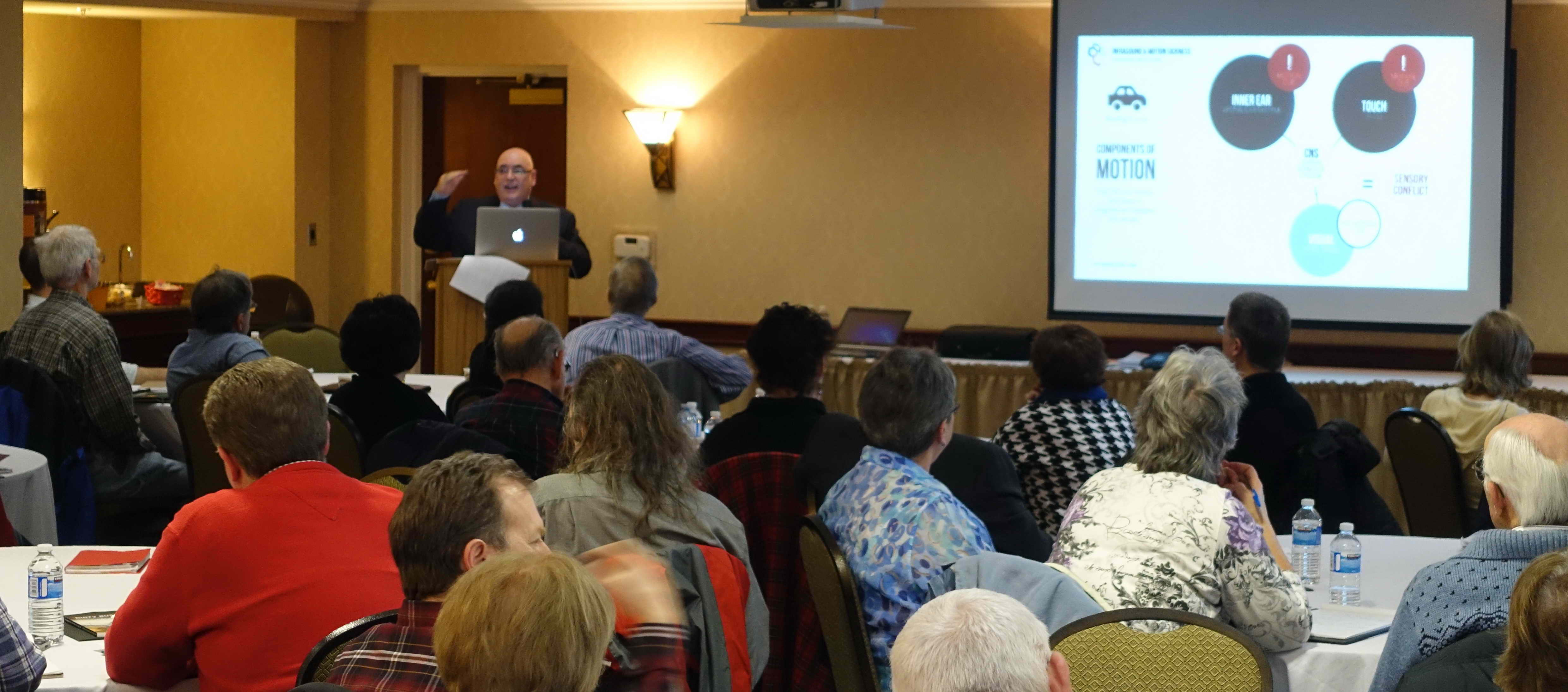
Not everyone exposed to the infrasound produced by utility-scale wind turbines gets sick from it. But those who do, can get really ill, acoustics specialist Kevin A. Dooley told a packed audience at Wind Concerns Ontario’s conference Saturday, in Guelph Ontario.
Testing of infrasound inside and outside homes confirms that the infrasound produced by large wind turbines is “symmetrical,” Dooley said, and provides a false cue to the human body which results in “sensory conflict.”
A sensory conflict occurs, Dooley said, “when sensory inputs from one or more senses conflict with other sensory inputs. Since infrasound is and has always been associated with motion in an atmosphere, sensory detection of infrasound without other motion cues will cause sensory conflict in some people, leading to motion sickness symptoms.”
These conclusions are supported by work done and published in 1985 by David Nussbaum, Dooley explained.
About 15 percent of people exposed will experience dizziness, nausea, headaches and other symptoms, he said. “That’s in line with the recent Health Canada research, which shows 16.5 percent of people in close proximity showing distress.”
Mr Dooley, who has more than 100 patents to his name for technological solutions to problems with noise and other issues, has published several papers on wind turbines and infrasound.
The research is there, he said. The wind power companies say that there is no link between the infrasound produced by their turbines and human health, but that is incorrect, he said.
What is needed now, Dooley concluded, is research done by “an independent institution” so that government policy and regulations can be altered to protect the health of residents forced to live near wind turbines.
For more information on Mr Dooley and his research, go to his website.



5 Comments
David Libby
I hope the term “research” was not suggesting human experiments. Since governments are already aware of this damage and continuing to inflict it.
http://www.cirp.org/library/ethics/nuremberg/
The judgment by the war crimes tribunal at Nuremberg laid down 10 standards to which physicians must conform when carrying out experiments on human subjects in a new code that is now accepted worldwide.
This judgment established a new standard of ethical medical behavior for the post World War II human rights era. Amongst other requirements, this document enunciates the requirement of voluntary informed consent of the human subject. The principle of voluntary informed consent protects the right of the individual to control his own body.
This code also recognizes that the risk must be weighed against the expected benefit, and that unnecessary pain and suffering must be avoided.
This code recognizes that doctors should avoid actions that injure human patients.
The principles established by this code for medical practice now have been extened into general codes of medical ethics.
Sommer
Thank you David.I’ve always wondered how the wind companies could proceed without having done thorough scientific studies on infra sound.
This is the first item of the Nuremberg Code regarding experiments.
1. The voluntary consent of the human subject is absolutely essential.
This means that the person involved should have legal capacity to give consent; should be so situated as to be able to exercise free power of choice, without the intervention of any element of force, fraud, deceit, duress, overreaching, or other ulterior form of constraint or coercion; and should have sufficient knowledge and comprehension of the elements of the subject matter involved as to enable him to make an understanding and enlightened decision. This latter element requires that before the acceptance of an affirmative decision by the experimental subject there should be made known to him the nature, duration, and purpose of the experiment; the method and means by which it is to be conducted; all inconveniences and hazards reasonably to be expected; and the effects upon his health or person which may possibly come from his participation in the experiment.
The duty and responsibility for ascertaining the quality of the consent rests upon each individual who initiates, directs or engages in the experiment. It is a personal duty and responsibility which may not be delegated to another with impunity.
Grant
CanWEA lobbied the Ministry of the Environment against monitoring infrasound a loow frequency noise. In a July 24, 2009 letter to Marcia Wallace as a part of the EBR for wind turbine regulations, CanWEA stated, “Page 15, “Conditions of Approval” – CanWEA takes issue with the requirement for infrasound monitoring as the current scientific evidence clearly shows this is not an issue. Studies across the world have shown that turbines do not produce infrasound at levels anywhere near those that can have an impact on humans. No peer-reviewed study has ever established a link between infrasound from turbines and human health, therefore CanWEA submits that the proposed requirement for infrasound or low frequency noise monitoring as a condition of the REA be removed.”
Mike Jankowski
I’ve also earlier commented about potential conflict with the Nuremberg code. It is ridiculous that, in the face of many reports of negative health impacts and descriptions of low frequency noise and vibration observed in connect, that our own MoE&CC continues to not include infrasound and Low Frequency noise in its guidelines based on the results of a “Google search of available materials” performed by a qualified individual back in 2010.
How do we fire these people?
Richard Mann
Research ethics says that we should get volunteers, from the community. Not from the turbine areas.
Our Governments are testing on human subjects.
We have an severe ethics problem and nobody wants to talk about it.